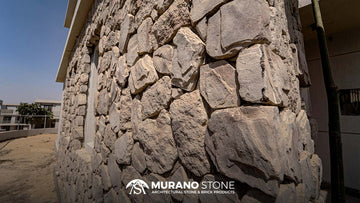Imagine transforming your building projects with a material that combines the timeless beauty of natural stone with modern innovation without the heavy lifting, high costs, or maintenance challenges.
Welcome to the world of artificial stone, where creativity meets practicality. Whether you're designing a sleek commercial facade, a cozy family home, or an elegant outdoor space, artificial stone opens up new possibilities for builders, designers, and homeowners alike.
This blog explains the many usages of artificial stone in construction, showcasing how it can elevate your projects, provide durability, and offer stunning aesthetics keeping budget and maintenance in check. From outdoor cladding to interior feature walls, artificial stone is reshaping the way we approach building materials. Let’s explore how this adaptable material can make your next project stand out, combining both form and function effortlessly.
Usages of Artificial Stone in Construction?
Before we explain the specific usages of artificial stone in building and construction, it’s important to understand why this material has become such a go-to solution.
The advantages of using artificial stone are numerous:
Affordability: Compared to natural stone, artificial stone is significantly more affordable. Its production process allows manufacturers to create large quantities without the need for extensive quarrying, which can drive up the cost of natural stone.
- Durability: Artificial stone is designed to be highly durable, often more so than natural stone. It resists cracking, chipping, and fading, making it ideal for both interior and exterior applications.
- Lightweight: Artificial stone is much lighter than natural stone, which simplifies transportation and installation. This is particularly important in construction projects where weight restrictions are a concern, such as on upper floors of buildings.
- Design Flexibility: Available in a wide range of colors, textures, and finishes, artificial stone can be tailored to meet any design concept. Whether you’re aiming for a rustic look, a sleek modern aesthetic, or something in between, artificial stone can help you achieve it.
- Eco-Friendly: Many types of artificial stone are made from recycled materials, reducing the environmental impact of construction projects. Additionally, because it doesn’t require quarrying like natural stone, artificial stone helps to conserve natural resources.
Now that we’ve covered the benefits, let’s explore the specific usages of artificial stone in building and construction.
1. Exterior Cladding and Facades
One of the most common usages of artificial stone in construction is for exterior cladding and facades. Artificial stone can be applied to the outer walls of buildings to create a stunning, stone-like appearance that enhances curb appeal and adds a layer of durability.
Why Use Artificial Stone for Exterior Cladding?
-
Lightweight: As mentioned earlier, artificial stone is lighter than natural stone, making it easier to install on large surfaces.
-
Weather Resistance: Artificial stone is designed to withstand various weather conditions, including rain, heat, and frost. This makes it a perfect choice for exterior applications where exposure to the elements is a concern.
-
Cost-Effective: Exterior cladding can be expensive when using natural stone. Artificial stone provides a more affordable option that still delivers the same luxurious look.
Applications:
- Residential homes: Add texture and elegance to the exterior walls of houses, enhancing their architectural design.
- Commercial buildings: Create an upscale facade that stands out without breaking the budget.
- Public buildings: From schools to libraries, artificial stone facades can give buildings a timeless and professional appearance.
2. Landscaping and Outdoor Spaces
Artificial stone is also widely used in landscaping and outdoor construction projects. Its versatility makes it an excellent choice for creating walkways, garden walls, outdoor kitchens, and patios.
Why Use Artificial Stone in Landscaping?
- Durability: Artificial stone can withstand outdoor elements, including heavy foot traffic, rain, and UV exposure, without losing its color or structure.
- Customizability for project owners: Available in various shapes, sizes, and textures, artificial stone can be tailored to fit any outdoor design concept, whether you're aiming for a contemporary look or a more natural feel.
- Low Maintenance: Unlike natural stone, which may require sealing and frequent cleaning, artificial stone is generally low maintenance, making it ideal for outdoor applications.
Applications:
Patios and walkways:
- Create beautiful, durable paths and patio spaces with artificial stone pavers. These pavers can be customized to mimic the look of flagstone, slate, or cobblestone, depending on your design preferences.
- Retaining walls: Use artificial stone to build retaining walls that are both functional and visually appealing. These walls help manage soil erosion while adding a touch of elegance to your landscape.
3. Interior Design and Feature Walls
Another growing usage of artificial stone in construction is in interior design, particularly for feature walls, fireplace surrounds, and accent pieces.
Why Use Artificial Stone for Interior Design?
- Versatile Aesthetic: Whether you're looking to add a rustic charm to your living room or a sleek modern look to your office, artificial stone offers endless design possibilities.
- Ease of Installation: Since it’s lightweight and often comes in panels or tiles, artificial stone is easy to install, even on indoor surfaces.
Applications:
- Feature Walls: Use artificial stone to create striking feature walls in living rooms, bedrooms, or entryways. The texture and depth of the stone add visual interest and a sense of luxury.
- Kitchen Backsplashes: Add texture and elegance to your kitchen with an artificial stone backsplash. It’s easy to clean and provides a unique focal point in your kitchen.
4. Structural and Decorative Elements
Artificial stone can also be used to create structural and decorative elements within a building or outdoor space. From columns and arches to window sills and door surrounds, artificial stone adds a touch of class and architectural interest to any project.
Why Use Artificial Stone for Decorative Elements?
- Lightweight and Customizable: Since artificial stone is lighter and easier to work with than natural stone, it can be molded into intricate shapes and designs, making it ideal for architectural details.
- Consistency: Artificial stone offers consistent color and texture, ensuring that decorative elements look uniform and cohesive throughout a project.
Applications:
Columns and Pillars: Add a sense of grandeur to any space with artificial stone columns or pillars. These can be used indoors or outdoors to create an architectural focal point. Window Sills and Door Surrounds: Use artificial stone to frame windows and doors, enhancing the overall design of your building. Arches and Cornices: Create elegant arches or cornices with artificial stone for a timeless architectural feature.
Conclusion: The Endless Possibilities of Artificial Stone in Construction
The usages of artificial stone in building and construction are truly limitless. From exterior cladding and landscaping to interior design and structural elements, artificial stone provides a versatile, durable, and cost-effective solution for a wide range of projects. Its ability to mimic the look and feel of natural stone while offering additional benefits makes it a top choice for architects, builders, and homeowners alike.
At Murano Stone, we offer a wide selection of high-quality artificial stone products designed to meet the needs of modern construction projects.
Explore our artificial stone collection today and discover how artificial stone can elevate your next building or renovation project.



